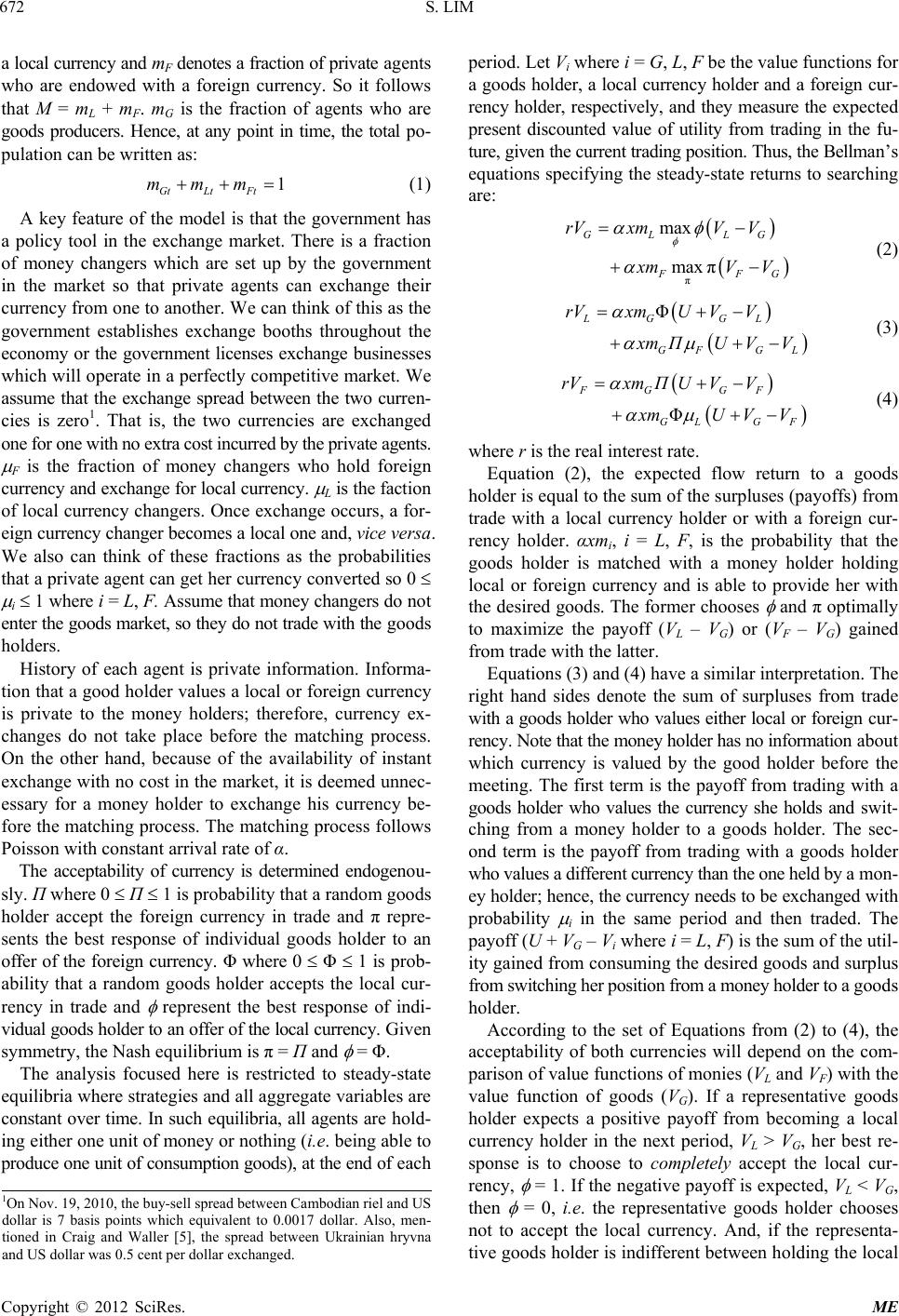
S. LIM
672
a local currency and mF denotes a fraction of private agents
who are endowed with a foreign currency. So it follows
that M = mL + mF. mG is the fraction of agents who are
goods producers. Hence, at any point in time, the total po-
pulation can be written as:
1
Lt Ft
mmm
π
max
max π
GL LG
Gt (1)
A key feature of the model is that the government has
a policy tool in the exchange market. There is a fraction
of money changers which are set up by the government
in the market so that private agents can exchange their
currency from one to another. We can think of this as the
government establishes exchange booths throughout the
economy or the government licenses exchange businesses
which will operate in a perfectly competitive market. We
assume that the exchange spread between the two curren-
cies is zero1. That is, the two currencies are exchanged
one for one with no extra cost incurred by the private agents.
F is the fraction of money changers who hold foreign
currency and exchange for local currency.
L is the faction
of local currency changers. Once exchange occurs, a for-
eign currency changer becomes a local one and, vice versa.
We also can think of these fractions as the probabilities
that a private agent can get her currency converted so 0
i 1 where i = L, F. Assume that money changers do not
enter the goods market, so they do not trade with the goods
holders.
History of each agent is private information. Informa-
tion that a good holder values a local or foreign currency
is private to the money holders; therefore, currency ex-
changes do not take place before the matching process.
On the other hand, because of the availability of instant
exchange with no cost in the market, it is deemed unnec-
essary for a money holder to exchange his currency be-
fore the matching process. The matching process follows
Poisson with constant arrival rate of α.
The acceptability of currency is determined endogenou-
sly. Π where 0 Π 1 is probability that a random goods
holder accept the foreign currency in trade and π repre-
sents the best response of individual goods holder to an
offer of the foreign currency. Φ where 0 Φ 1 is prob-
ability that a random goods holder accepts the local cur-
rency in trade and
represent the best response of indi-
vidual goods holder to an offer of the local currency. Given
symmetry, the Nash equilibrium is π = Π and
= Φ.
The analysis focused here is restricted to steady-state
equilibria where strategies and all aggregate variables are
constant over time. In such equilibria, all agents are hold-
ing either one unit of money or nothing (i.e. being able to
produce one unit of consumption goods), at the end of each
period. Let Vi where i = G, L, F be the value functions for
a goods holder, a local currency holder and a foreign cur-
rency holder, respectively, and they measure the expected
present discounted value of utility from trading in the fu-
ture, given the current trading position. Thus, the Bellman’s
equations specifying the steady-state returns to searching
are:
FG
rVxmV V
mVV
(2)
Φ
LG GL
GF GL
rVxmU VV
xm ΠUV V
(3)
Φ
FG GF
GLG F
rVxm ΠUV V
mUVV
(4)
where r is the real interest rate.
Equation (2), the expected flow return to a goods
holder is equal to the sum of the surpluses (payoffs) from
trade with a local currency holder or with a foreign cur-
rency holder. αxmi, i = L, F, is the probability that the
goods holder is matched with a money holder holding
local or foreign currency and is able to provide her with
the desired goods. The former chooses
and π optimally
to maximize the payoff (VL – VG) or (VF – VG) gained
from trade with the latter.
Equations (3) and (4) have a similar interpretation. The
right hand sides denote the sum of surpluses from trade
with a goods holder who values either local or foreign cur-
rency. Note that the money holder has no information about
which currency is valued by the good holder before the
meeting. The first term is the payoff from trading with a
goods holder who values the currency she holds and swit-
ching from a money holder to a goods holder. The sec-
ond term is the payoff from trading with a goods holder
who values a different currency than the one held by a mon-
ey holder; hence, the currency needs to be exchanged with
probability
i in the same period and then traded. The
payoff (U + VG – Vi where i = L, F) is the sum of the util-
ity gained from consuming the desired goods and surplus
from switching her position from a money holder to a goods
holder.
According to the set of Equations from (2) to (4), the
acceptability of both currencies will depend on the com-
parison of value functions of monies (VL and VF) with the
value function of goods (VG). If a representative goods
holder expects a positive payoff from becoming a local
currency holder in the next period, VL > VG, her best re-
sponse is to choose to completely accept the local cur-
rency,
= 1. If the negative payoff is expected, VL < VG,
then
= 0, i.e. the representative goods holder chooses
not to accept the local currency. And, if the representa-
tive goods holder is indifferent between holding the local
1On Nov. 19, 2010, the buy-sell spread between Cambodian riel and US
dollar is 7 basis points which equivalent to 0.0017 dollar. Also, men-
tioned in Craig and Waller [5], the spread between Ukrainian hryvna
and US dollar was 0.5 cent per dollar exchanged.
Copyright © 2012 SciRes. ME